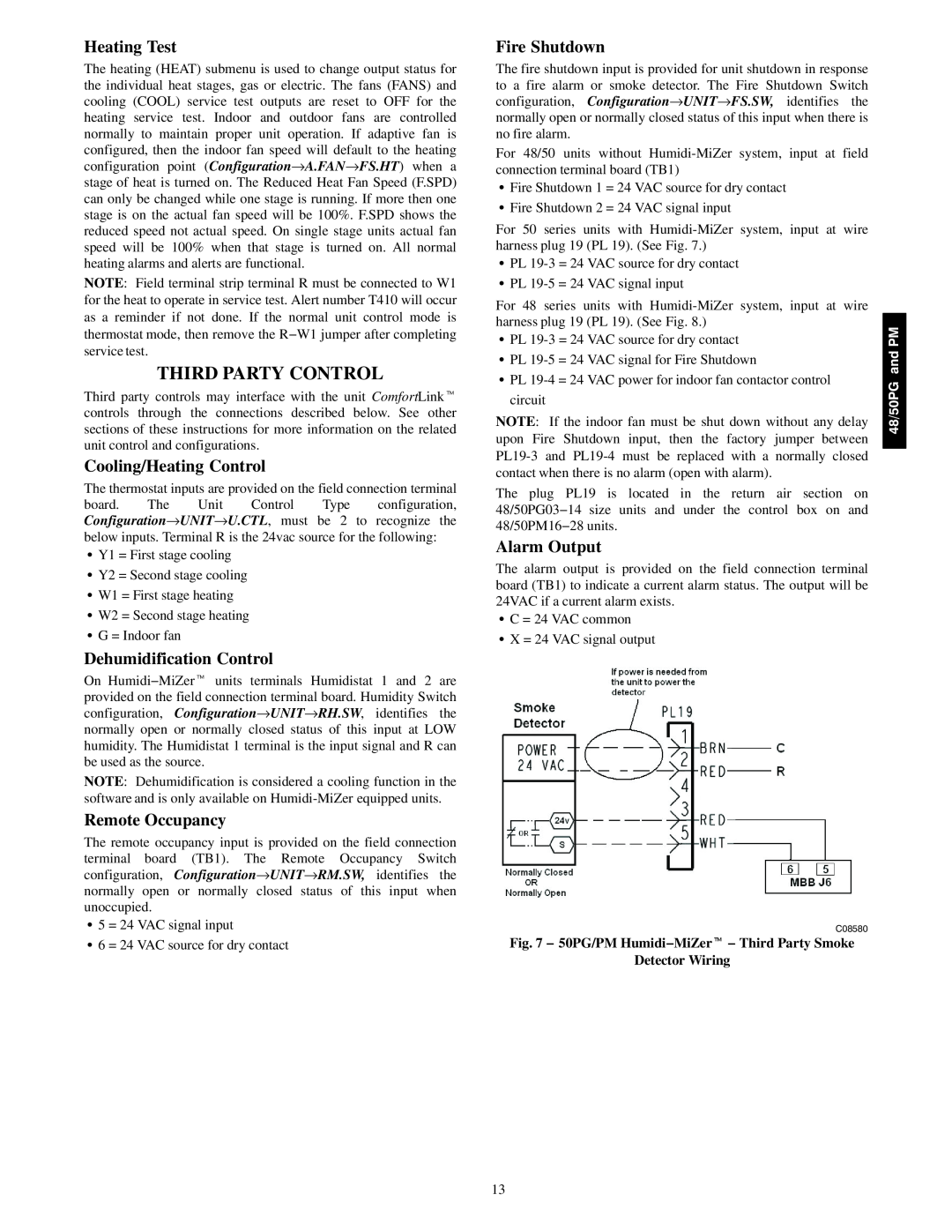
Heating Test
The heating (HEAT) submenu is used to change output status for the individual heat stages, gas or electric. The fans (FANS) and cooling (COOL) service test outputs are reset to OFF for the heating service test. Indoor and outdoor fans are controlled normally to maintain proper unit operation. If adaptive fan is configured, then the indoor fan speed will default to the heating configuration point (Configuration→A.FAN→FS.HT) when a stage of heat is turned on. The Reduced Heat Fan Speed (F.SPD) can only be changed while one stage is running. If more then one stage is on the actual fan speed will be 100%. F.SPD shows the reduced speed not actual speed. On single stage units actual fan speed will be 100% when that stage is turned on. All normal heating alarms and alerts are functional.
NOTE: Field terminal strip terminal R must be connected to W1 for the heat to operate in service test. Alert number T410 will occur as a reminder if not done. If the normal unit control mode is thermostat mode, then remove the R−W1 jumper after completing service test.
THIRD PARTY CONTROL
Third party controls may interface with the unit ComfortLinkt controls through the connections described below. See other sections of these instructions for more information on the related unit control and configurations.
Cooling/Heating Control
The thermostat inputs are provided on the field connection terminal
board. The Unit Control Type configuration, Configuration→UNIT→U.CTL, must be 2 to recognize the below inputs. Terminal R is the 24vac source for the following:
SY1 = First stage cooling
SY2 = Second stage cooling
SW1 = First stage heating
SW2 = Second stage heating
SG = Indoor fan
Dehumidification Control
On Humidi−MiZert units terminals Humidistat 1 and 2 are provided on the field connection terminal board. Humidity Switch configuration, Configuration→UNIT→RH.SW, identifies the normally open or normally closed status of this input at LOW humidity. The Humidistat 1 terminal is the input signal and R can be used as the source.
NOTE: Dehumidification is considered a cooling function in the software and is only available on
Remote Occupancy
The remote occupancy input is provided on the field connection terminal board (TB1). The Remote Occupancy Switch configuration, Configuration→UNIT→RM.SW, identifies the normally open or normally closed status of this input when unoccupied.
S5 = 24 VAC signal input
S6 = 24 VAC source for dry contact
Fire Shutdown
The fire shutdown input is provided for unit shutdown in response |
| |
to a fire alarm or smoke detector. The Fire Shutdown Switch |
| |
configuration, Configuration→UNIT→FS.SW, identifies the |
| |
normally open or normally closed status of this input when there is |
| |
no fire alarm. |
| |
For 48/50 units without |
| |
connection terminal board (TB1) |
| |
S Fire Shutdown 1 = 24 VAC source for dry contact |
| |
S Fire Shutdown 2 = 24 VAC signal input |
| |
For 50 series units with |
| |
harness plug 19 (PL 19). (See Fig. 7.) |
| |
S PL |
| |
S PL |
| |
For 48 series units with |
| |
harness plug 19 (PL 19). (See Fig. 8.) | PM | |
S PL | ||
S PL | and | |
| ||
S PL | 48/50PG | |
circuit | ||
| ||
NOTE: If the indoor fan must be shut down without any delay |
| |
upon Fire Shutdown input, then the factory jumper between |
| |
| ||
contact when there is no alarm (open with alarm). |
| |
The plug PL19 is located in the return air section on |
| |
48/50PG03−14 size units and under the control box on and |
| |
48/50PM16−28 units. |
| |
Alarm Output |
|
The alarm output is provided on the field connection terminal board (TB1) to indicate a current alarm status. The output will be 24VAC if a current alarm exists.
SC = 24 VAC common
SX = 24 VAC signal output
C08580
Fig. 7 − 50PG/PM Humidi−MiZert − Third Party Smoke
Detector Wiring
13
